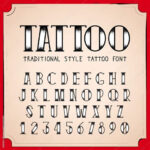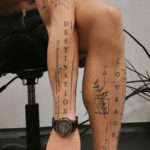Getting a tattoo is an exciting experience, and the initial reveal of fresh ink is often met with pride and satisfaction. The vision of a sharp, clean design permanently etched on your skin is well worth the momentary discomfort. However, the emergence of a blurry or smudged tattoo can be a disheartening outcome. Tattoo blowout is a frustrating complication that results in a diffused, unclear tattoo, and unfortunately, it’s a permanent issue unless addressed with further procedures. While tattoo blowout cannot be reversed on its own, it is largely preventable.
To understand tattoo blowout comprehensively, we consulted with experienced professionals in the field: tattoo artists Crys and Nesheva, and board-certified dermatologist Dr. Campbell. Their expert insights provide a well-rounded perspective on what tattoo blowout is, how it occurs, and what can be done about it.
Understanding Tattoo Blowout
If you’ve recently received a tattoo and notice a hazy, blurred, or smudged appearance around the tattoo lines during or after the healing phase, you might be experiencing tattoo blowout. “Blowout occurs when tattoo ink extends beyond the intended lines, penetrating into the deeper layers of the skin where fat and veins are located, or due to scarring,” explains Crys. “It’s easily recognizable by the noticeable blurring effect that diffuses outwards from the tattoo’s edges.”
The Mechanics Behind Tattoo Blowout
While improper aftercare can sometimes contribute to minor ink migration, tattoo blowout primarily stems from errors during the tattooing process itself. A tattoo is created by injecting ink into the dermis, the layer of skin beneath the epidermis. Blowout is an indication that the tattoo ink has been deposited too deeply, passing through the dermis and reaching the hypodermis. “The hypodermis is where fat, veins, and larger blood vessels reside,” Crys clarifies. Essentially, blowout arises from the tattoo artist’s technique causing excessive trauma to the skin, leading the ink to spread beyond the intended design boundaries.
Nesheva elaborates on the technical aspects, stating, “Blowout can occur if a tattoo artist applies the tattoo needle too deeply into the skin, lacks focus and precision during the process, or holds the tattoo machine at an incorrect angle. When ink is deposited too deeply, it reaches the fat layer, which is the primary cause of tattoo blowout.” This emphasizes the importance of needle depth and angle control in preventing this issue.
Potential Complications of Tattoo Blowout
While tattoo blowout is not a sign of infection, it can lead to unwanted scarring and the undesirable spread of ink into the skin surrounding the tattoo. Dr. Campbell clarifies the distinction: “Tattoo blowout is distinct from tattoo infections or allergic reactions. Infections arise when unsanitary instruments or contaminated pigments introduce infectious organisms into the skin. Allergic reactions, on the other hand, are triggered by specific tattoo pigment components, particularly red tattoo ink.” It’s crucial to understand that blowout is a mechanical issue of ink placement, not a biological reaction to the ink itself.
Addressing Tattoo Blowout: Correction and Removal
Unfortunately, once tattoo blowout has occurred, there is no way to simply reverse it. Correcting a blown-out tattoo requires further intervention. The primary options for dealing with tattoo blowout are tattoo correction and tattoo removal.
Tattoo Correction Strategies
One approach to managing tattoo blowout is through tattoo correction. This might involve a complete cover-up tattoo, where a new design is created to completely conceal the original, blown-out tattoo. Alternatively, in some cases, a skilled tattoo artist can work with the existing blurred lines to refine and clean up the design. This requires finding an artist experienced in correction work who can skillfully navigate the already-tattooed and potentially scarred skin to improve its appearance.
If you choose the correction route, patience is key. You must wait for the original tattoo to fully heal before undergoing any further tattooing. This healing period can extend for two weeks or longer, meaning you’ll need to live with the blown-out tattoo during this time. Furthermore, a cover-up or correction tattoo will likely need to be larger and bolder than your initial design. Collaborate closely with your chosen artist to develop a design that you’ll love, taking into account these limitations.
Tattoo Removal Options
Laser tattoo removal presents another effective solution for tattoo blowout. “Blowout can be effectively treated using lasers commonly employed for tattoo removal, such as Q-Switched ND:YAG lasers or picosecond lasers like the PicoWay system,” explains Dr. Campbell.
These laser technologies, widely used for full tattoo removal, can also be precisely targeted to address specific areas of blowout. Through a series of laser sessions, the blurry, diffused ink can be gradually faded and eliminated, restoring the desired crispness to the tattoo design. For a more comprehensive solution, you can also opt for complete laser tattoo removal to eliminate the entire blown-out tattoo.
Preventing Tattoo Blowout: Key Strategies
Prevention is always the best approach, and tattoo blowout is no exception. Fortunately, there are several proactive steps you can take to significantly reduce the risk of blowout.
Choosing an Experienced Tattoo Artist
The most critical factor in preventing tattoo blowout is selecting a skilled and experienced tattoo artist. As Dr. Campbell emphasizes, “The easiest and most effective way to prevent tattoo blowout is to choose an experienced tattoo artist who thoroughly understands the correct depth for tattoo pigment placement within the skin.”
Thorough research to find a reputable and experienced artist is essential, not only to ensure you like their artistic style but also to minimize the chances of complications like tattoo blowout.
Nesheva provides valuable advice on evaluating an artist’s portfolio: “It’s extremely important to carefully examine an artist’s work, zooming in on photos to assess the sharpness and precision of their tattoo lines. Always request to see healed tattoo examples from their previous clients. This will give you a realistic view of how their tattoos hold up over time and the quality of their linework after healing.”
Strategic Tattoo Placement
Tattoo placement also plays a role in blowout risk. Areas of the body with thinner skin, such as the inner elbow or the top of the foot, are inherently more prone to blowout because they require a lighter touch and greater precision from the tattoo artist. If you’re concerned about the possibility of blowout, consider choosing a tattoo location with thicker skin, where the risk is generally lower.
Diligent Aftercare Practices
Once you’ve chosen a reputable artist, following aftercare instructions diligently is the next crucial step in preventing complications. Proper aftercare supports the healing process and minimizes the risk of issues like blowout. This includes cleaning your tattoo twice daily with a mild cleanser and keeping it moisturized with a recommended tattoo aftercare product until it’s fully healed, typically for at least two weeks. It’s also vital to avoid scratching or picking at the tattoo during healing, as Nesheva advises.
“Avoid stretching or pulling the tattooed skin during the healing period,” Nesheva cautions. “Stretching and pulling can encourage the ink to spread beyond the intended tattoo lines, contributing to the blowout effect. Furthermore, it can prolong the healing process and increase the risk of infection, especially if you touch the tattoo with unwashed hands.”
Key Takeaways on Tattoo Blowout
Tattoo blowout is an unwelcome complication that can negatively impact the appearance of your new tattoo, distorting the intended design and detracting from its overall aesthetic. The most effective strategy for avoiding tattoo blowout is proactive prevention: choosing a highly skilled artist with a proven track record of clean linework. “Blowouts are primarily prevented on the artist’s end through proper technique and experience,” Crys reiterates. “Thoroughly research artists, scrutinize their portfolios for healed tattoos, and don’t hesitate to ask questions. And remember, proper aftercare is always essential!”
However, even with the most careful artist selection, blowout can still occasionally occur. If you find yourself facing a blown-out tattoo, use the healing period to consider your options: tattoo correction with a cover-up or refinement, or laser tattoo removal to address the blowout and potentially the entire tattoo. By understanding the causes of tattoo blowout and taking preventative measures, you can significantly increase your chances of enjoying a crisp, clean, and beautifully executed tattoo for years to come.

